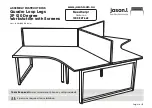
7-5
•
Non-condensables in the system or a faulty head pressure gauge
—
Check standby pressures against
refrigerant tables.
•
Incorrectly set or defective water regulator valve
—
Check setting and operation.
•
Partly closed compressor discharge service valve
—
Check the stem position to confirm that it is
backseated.
•
High-temperature water entering the condenser. Check the cooling tower fan and system.
If none of these problems exist, or they have been resolved, determine the temperature difference between the
water leaving the condenser and the refrigerant condensing temperature (saturation temperature [refer to
Table 26: Pressure-Temperature Chart], corresponding to the head pressure). If this difference exceeds 10°F
(5.6°C), cleaning is required because the difference indicates that good heat transfer is not occurring.
If the difference is less than 8°F (4.5°C), something other than a fouled condenser may be the cause of high head
pressure. During normal operation, the temperature difference stays between 5°F and 10°F (2.8°C and 5.6°C)
regardless of water inlet temperature, when the water flow is regulated by a pressure-operated water valve. If
the difference is less than 5°F (2.8°C), restricted water flow or a low supply pressure is likely. A restriction can be
caused by foreign matter in the condenser, but it is likely to be elsewhere in the system.
Draining
Draining of water-cooled condensers is recommended in climates where units may be left exposed to ambient
temperatures below 32°F (0°C). Although condensers usually have a vent and drain fittings, the opening of these
fittings is not sufficient for a natural gravity flow of water. Water is thus retained in the tube due to the surface
tension between the tube and the water and the normal curvature between tube supports.
Experience shows that as much as 20% of the water in the condenser is retained. To break the surface tension
between the water and the tubes and to drain all tubes completely, the condenser must be tilted a minimum of
5 degrees. Whether water left in the tubes causes damage depends on how quickly the water freezes and its
location inside the condenser. Condenser manufacturers recommend that each tube is blown out individually
with compressed air to remove the water. Alternatively, a minimum of 25% ethylene glycol in the system will
also prevent the water from freezing, which can rupture the tubes.
Chemical Cleaning
Vogt Ice, LLC, makes no recommendation for any particular chemical preparation because the same chemical
may not be effective in all circumstances.
The warranty on condensers is void if they are damaged by improper cleaning tools or methods.
If harsh chemicals are used, be sure to follow the manufacturer’s recommendations regarding safe handling of
those solutions.
Follow these directions and precautions when cleaning:
•
Use only preparations from an established, reliable source.
•
Follow directions exactly, particularly regarding amounts to use, and flushing or neutralizing procedures
after cleaning.
•
Close the water supply to the stop valve and remove the condenser water regulating valve.
•
Circulate the solution through the condenser until it is considered clean (no excess scale on tubes or
tubesheets).
•
Flush the condenser according to the directions provided by the chemical manufacturer.
•
Reinstall the water regulating valve and associated piping.
•
Open the water-supply stop valve and check for leaks.
Содержание Tube-Ice HFO10
Страница 2: ......
Страница 6: ......
Страница 10: ......
Страница 12: ......
Страница 16: ...2 4 Figure 3 Water Cooled Piping Schematic ...
Страница 17: ...2 5 Figure 4 Air Cooled Piping Schematic ...
Страница 36: ......
Страница 40: ......
Страница 43: ...6 3 Figure 16 Panel Layout 60 Hz Non CE Machines ...
Страница 44: ...6 4 Figure 17 Electrical Schematic Control Circuit All Voltages 50 Hz ...
Страница 45: ...6 5 Figure 18 Electrical Schematic Control Circuit All Voltages 60 Hz ...
Страница 46: ...6 6 Figure 19 Electrical Schematic 3 Phase Power All Voltages 50 Hz ...
Страница 47: ...6 7 Figure 20 Electrical Schematic 3 Phase Power All Voltages 60 Hz ...
Страница 68: ......
Страница 96: ......
Страница 110: ...Notes ...
Страница 111: ...Notes ...
















































